The Unexpected Chemistry of Thiacalix[4]arene Monosulfoxide
Abstract
:1. Introduction
2. Results and Discussion
3. Materials and Methods
3.1. General Experimental Procedures
3.2. Synthetic Procedures
3.2.1. Tetramethoxy Derivative 2
3.2.2. Tetramethoxy Sulfoxide Derivative 3
3.2.3. Attempted Dealkylation of Compound 3
3.2.4. Boron Complex 5 (from 4)
3.2.5. Reaction of Thiacalixarene 2 with BBr3
3.2.6. Compound 6 (from 5)
3.2.7. Compound 8
3.2.8. Compound 9
3.2.9. Thiacalixarene Monosulfoxide 4
3.2.10. Thiacalixarene 10
3.3. X-ray Measurements
3.3.1. Crystallographic Data for 4
3.3.2. Crystallographic Data for 5
3.3.3. Crystallographic Data for 6
3.3.4. Crystallographic Data for 10
4. Conclusions
Supplementary Materials
Author Contributions
Funding
Institutional Review Board Statement
Informed Consent Statement
Data Availability Statement
Conflicts of Interest
Sample Availability
References
- Mandolini, L.; Ungaro, R. Calixarenes in Action; World Scientific Publishing Company: Singapore, 2000. [Google Scholar]
- Asfari, Z.; Böhmer, V.; Harrowfield, J.; Vicens, J. Calixarenes 2001; Kluwer Academic Publishers: Dordrecht, The Netherlands, 2001. [Google Scholar]
- Vicens, J.; Harrowfield, J.; Baklouti, L. Calixarenes in the Nanoworld; Springer: Dordrecht, The Netherlands, 2007. [Google Scholar]
- Gutsche, C.D.; Chemistry, R.S.O. Calixarenes: An Introduction; RSC Publishing: Cambridge, UK, 2008. [Google Scholar]
- Neri, P.; Sessler, J.L.; Wang, M.X. Calixarenes and Beyond; Springer: Cham, Germany, 2016. [Google Scholar]
- Kumagai, H.; Hasegawa, M.; Miyanari, S.; Sugawa, Y.; Sato, Y.; Hori, T.; Ueda, S.; Kamiyama, H.; Miyano, S. Facile synthesis of p-tert-butylthiacalix[4]arene by the reaction of p-tert-butylphenol with elemental sulfur in the presence of a base. Tetrahedron Lett. 1997, 38, 3971–3972. [Google Scholar] [CrossRef]
- Kumar, R.; Lee, Y.O.; Bhalla, V.; Kumar, M.; Kim, J.S. Recent developments of thiacalixarene based molecular motifs. Chem. Soc. Rev. 2014, 43, 4824–4870. [Google Scholar] [CrossRef] [PubMed]
- Morohashi, N.; Narumi, F.; Iki, N.; Hattori, T.; Miyano, S. Thiacalixarenes. Chem. Rev. 2006, 106, 5291–5316. [Google Scholar] [CrossRef] [PubMed]
- Lhoták, P. Chemistry of Thiacalixarenes. Eur. J. Org. Chem. 2004, 2004, 1675–1692. [Google Scholar] [CrossRef]
- Litwak, A.M.; Biali, S.E. Oxidative cyclization of calix[4]arenes. J. Org. Chem. 1992, 57, 1943–1945. [Google Scholar] [CrossRef]
- Agbaria, K.; Biali, S.E. Spirodienone Route for the Stereoselective Methylene Functionalization of p-tert-Butylcalix[4]arene. J. Am. Chem. Soc. 2001, 123, 12495–12503. [Google Scholar] [CrossRef]
- Agbaria, K.; Wöhnert, J.; Biali, S.E. Extraannular Fluorinated Calixarenes: Regiospecificity of the Deoxofluorination Reactions of Bis(spirodienol) Derivatives. J. Org. Chem. 2001, 66, 7059–7066. [Google Scholar] [CrossRef]
- Simaan, S.; Agbaria, K.; Biali, S.E. Functionalization of the Methylene Groups of p-tert-Butylcalix[4]arene: S−C, N−C, and C−C Bond Formation. J. Org. Chem. 2002, 67, 6136–6142. [Google Scholar] [CrossRef]
- Biali, S.E. The Spirodienone Route for the Functionalization of Calixarenes. Synlett 2003, 2003, 0001–0011. [Google Scholar] [CrossRef]
- Thulasi, S.; Savithri, A.; Varma, R.L. Calix[4]bis(spirodienone) as a versatile synthon for upper rim alkoxylation of calixarenes and synthesis of novel triazole-based biscalixarene by ‘CuAAC’ chemistry. Supramol. Chem. 2011, 23, 501–508. [Google Scholar] [CrossRef]
- Litwak, A.M.; Grynszpan, F.; Aleksiuk, O.; Cohen, S.; Biali, S.E. Preparation, stereochemistry, and reactions of the bis(spirodienone) derivatives of p-tert-butylcalix[4]arene. J. Org. Chem. 1993, 58, 393–402. [Google Scholar] [CrossRef]
- Morohashi, N.; Kojima, M.; Suzuki, A.; Ohba, Y. Conversion of Mono- and Tetra-Thiacalix[4]arenes to Sulfilimine Derivatives and Unexpected Formation of Monospirodienone derivatives. Heterocycl. Commun. 2005, 11, 249–254. [Google Scholar] [CrossRef]
- Polivkova, K.; Simanova, M.; Budka, J.; Curinova, P.; Cisarova, I.; Lhotak, P. Unexpected behavior of monospirothiacalix[4]arene under acidic conditions. Tetrahedron Lett. 2009, 50, 6347–6350. [Google Scholar] [CrossRef]
- Vrzal, L.; Kratochvilova-Simanova, M.; Landovsky, T.; Polivkova, K.; Budka, J.; Dvorakova, H.; Lhotak, P. Application of RDC enhanced NMR spectroscopy in structural analysis of thiacalix[4]arene derivatives. Org. Biomol. Chem. 2015, 13, 9610–9618. [Google Scholar] [CrossRef]
- Arnott, G.E. Inherently Chiral Calixarenes: Synthesis and Applications. Chem. Eur. J. 2018, 24, 1744–1754. [Google Scholar] [CrossRef]
- Szumna, A. Inherently chiral concave molecules-from synthesis to applications. Chem. Soc. Rev. 2010, 39, 4274–4285. [Google Scholar] [CrossRef]
- Kortus, D.; Eigner, V.; Lhotak, P. Regio- and stereoselectivity of spirodienone formation in 2,14-dithiacalix[4]arene. New J. Chem. 2021, 45, 8563–8571. [Google Scholar] [CrossRef]
- Lhotak, P.; Himl, M.; Stibor, I.; Sykora, J.; Dvorakova, H.; Lang, J.; Petrickova, H. Conformational behavior of tetramethoxythiacalix[4]arenes: Solution versus solid-state study. Tetrahedron 2003, 59, 7581–7585. [Google Scholar] [CrossRef]
- Kaiser, L.; Landovsky, T.; Salvadori, K.; Eigner, V.; Dvorakova, H.; Lhotak, P. Breaking thiacalix[4]arene into pieces—A novel synthetic approach to higher calixarenes bearing mixed (-S-, -CH2-) bridges. RSC Adv. 2021, 11, 36934–36941. [Google Scholar] [CrossRef]
- Fischer, C.; Katzsch, F.; Weber, E. Easily accessible symmetrically and unsymmetrically bridge disubstituted tetrahydroxycalix[4]arenes in advantageous trans-cone conformation. Tetrahedron Lett. 2013, 54, 2874–2877. [Google Scholar] [CrossRef]
- Han, B.; Wang, X.; Gao, Y.; Bai, M. Constructing a Nonfluorescent Conformation of AIEgen: A Tetraphenylethene Embedded in the Calix[4]arene’s Skeleton. Chem. A Eur. J. 2016, 22, 16037–16041. [Google Scholar] [CrossRef] [PubMed]
- Morohashi, N.; Kitahara, T.; Arima, T.; Tanaka, S.; Ohba, Y.; Hattori, T. Synthesis of Dinuclear Boron Complexes of Sulfinylcalix[4]arenes: Syn/Anti Stereocontrol by the Arrangement of the Sulfinyl Functions. Org. Lett. 2008, 10, 2845–2848. [Google Scholar] [CrossRef] [PubMed]
- Čubiňák, M.; Eigner, V.; Tobrman, T. Bench-Stable Sulfoxide-Based Boronates: Preparation and Application in a Tandem Suzuki Reaction. Adv. Synth. Catal. 2018, 360, 4604–4614. [Google Scholar] [CrossRef]
- Firouzabadi, H.; Jamalian, A. Reduction of oxygenated organosulfur compounds. J. Sulfur Chem. 2008, 29, 53–97. [Google Scholar] [CrossRef]
- Roy, C.D.; Brown, H.C. Dibromoborane-dimethyl sulfide: A new, mild, chemoselective reagent for the rapid deoxygenation of sulfoxides to sulfides†. J. Chem. Res. 2006, 2006, 642–644. [Google Scholar] [CrossRef]
- Guindon, Y.; Atkinson, J.G.; Morton, H.E. Deoxygenation of sulfoxides with boron bromide reagents. J. Org. Chem. 1984, 49, 4538–4540. [Google Scholar] [CrossRef]
- Georghiou, P.E.; Ashram, M.; Clase, H.J.; Bridson, J.N. Spirodienone and Bis(spirodienone) Derivatives of Calix[4]naphthalenes. J. Org. Chem. 1998, 63, 1819–1826. [Google Scholar] [CrossRef]
- Zhang, F.; Kumamaru, K.; Yamamoto, H. Synthesis, Conformational Studies and Inclusion Properties of Tetrakis[(2-pyridylmethyl)oxy]thiacalix[4]arenes. J. Incl. Phenom. Macrocycl. Chem. 2002, 42, 51–60. [Google Scholar] [CrossRef]
- Morohashi, N.; Katagiri, H.; Iki, N.; Yamane, Y.; Kabuto, C.; Hattori, T.; Miyano, S. Synthesis of All Stereoisomers of Sulfinylcalix[4]arenes1. J. Org. Chem. 2003, 68, 2324–2333. [Google Scholar] [CrossRef]
- Gutsche, C.D.; Bauer, L.J. Calixarenes. 13. The conformational properties of calix[4]arenes, calix[6]arenes, calix[8]arenes, and oxacalixarenes. J. Am. Chem. Soc. 1985, 107, 6052–6059. [Google Scholar] [CrossRef]
- Kusano, T.; Tabatabai, M.; Okamoto, Y.; Böhmer, V. The Cone-to-Cone Interconversion of Partially O-Methylated Calix[4]arenes: First Experimental Values for the Energy Barriers. J. Am. Chem. Soc. 1999, 121, 3789–3790. [Google Scholar] [CrossRef]
- Kortus, D.; Krizova, K.; Dvorakova, H.; Eigner, V.; Lhotak, P. Synthesis of 2,8-dithiacalix[4]arene based on fragment condensation. Tetrahedron Lett. 2021, 69, 152924. [Google Scholar] [CrossRef]
- Miksatko, J.; Eigner, V.; Kohout, M.; Lhotak, P. Regio-/stereoselective formation of monosulfoxides from thiacalix[4]arenes in all possible conformations. Tetrahedron Lett. 2017, 58, 1687–1691. [Google Scholar] [CrossRef]
- Miksatko, J.; Eigner, V.; Dvorakova, H.; Lhotak, P. Selective oxidation of thiacalix[4]arene (cone) to all corresponding sulfoxides. Tetrahedron Lett. 2016, 57, 3781–3784. [Google Scholar] [CrossRef]
- Heasley, V.L.; Elliott, S.L.; Erdman, P.E.; Figueroa, D.E.; Krosley, K.W.; Louie, T.J.; Moore, H.B.; Mudge, B.P.; Nogales, D.F.; Nordeen, J.; et al. Chlorination of α,β-unsaturated ketones and esters in the presence of acid scavengers. J. Chem. Soc. Perkin Trans. 2 1991, 393–399. [Google Scholar] [CrossRef]
- Wriede, U.; Fernandez, M.; West, K.F.; Harcour, D.; Moore, H.W. Synthesis of halodimethoxy-1,2-benzoquinones. J. Org. Chem. 1987, 52, 4485–4489. [Google Scholar] [CrossRef]
- Bruker. APEX4, SAINT and SADABS; Bruker AXS Inc.: Madison, WI, USA, 2021. [Google Scholar]
- Sheldrick, G. SHELXT—Integrated space-group and crystal-structure determination. Acta Crystallogr. Sect. A 2015, 71, 3–8. [Google Scholar] [CrossRef]
- Betteridge, P.; Carruthers, J.; Cooper, R.; Prout, K.; Watkin, D. CRYSTALS version 12: Software for guided crystal structure analysis. J. Appl. Crystallogr. 2003, 36, 1487. [Google Scholar] [CrossRef]
- Rohlíček, J.; Hušák, M. MCE2005–a new version of a program for fast interactive visualization of electron and similar density maps optimized for small molecules. J. Appl. Crystallogr. 2007, 40, 600–601. [Google Scholar] [CrossRef]
- Spek, A. Structure validation in chemical crystallography. Acta Crystallogr. Sect. D 2009, 65, 148–155. [Google Scholar] [CrossRef]
- Rigaku, O.D. CrysAlis PRO; Rigaku Oxford Diffraction Ltd.: Yarnton, UK, 2020. [Google Scholar]
- Palatinus, L.; Chapuis, G. SUPERFLIP—A computer program for the solution of crystal structures by charge flipping in arbitrary dimensions. J. Appl. Crystallogr. 2007, 40, 786–790. [Google Scholar] [CrossRef]
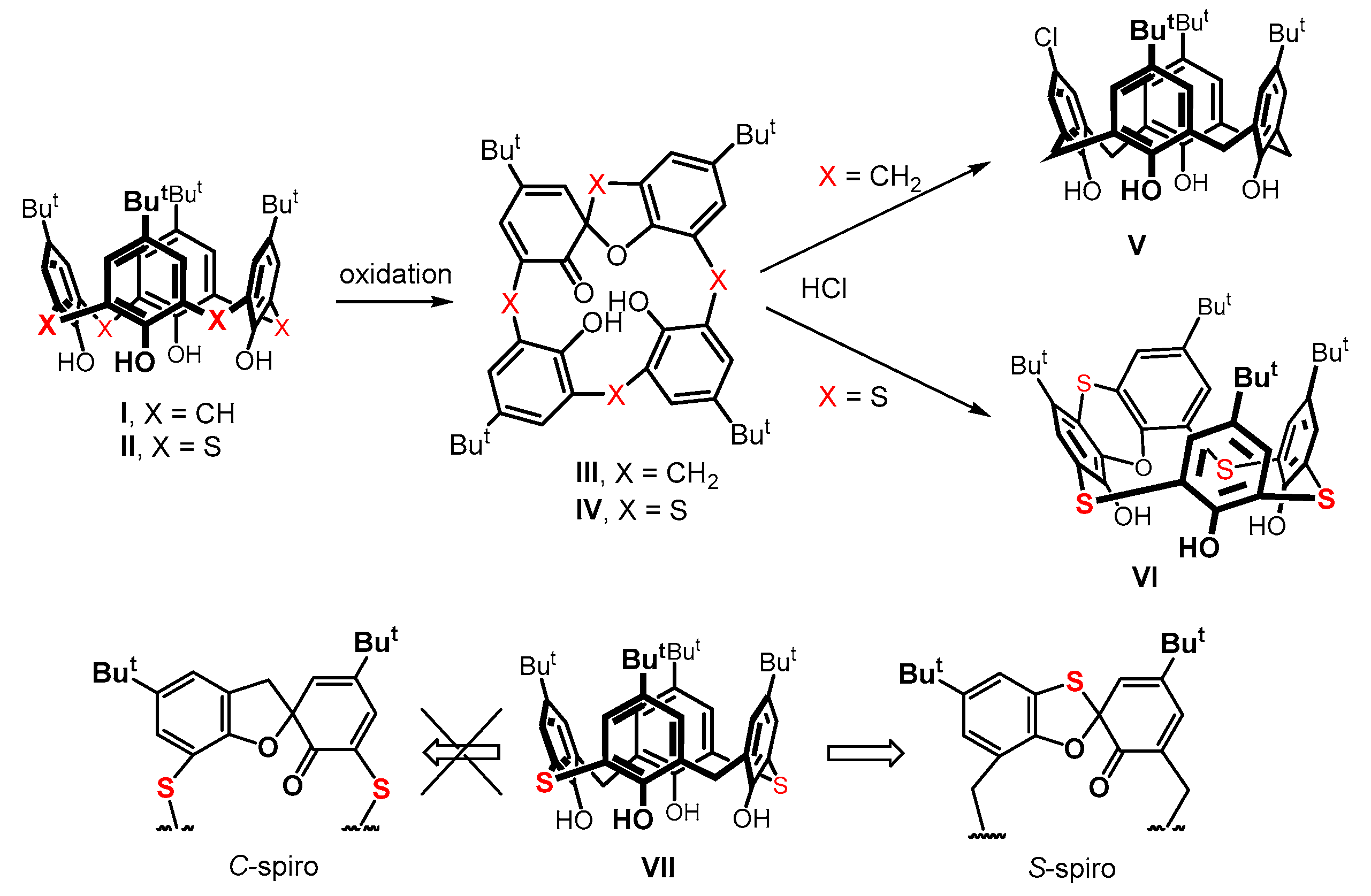
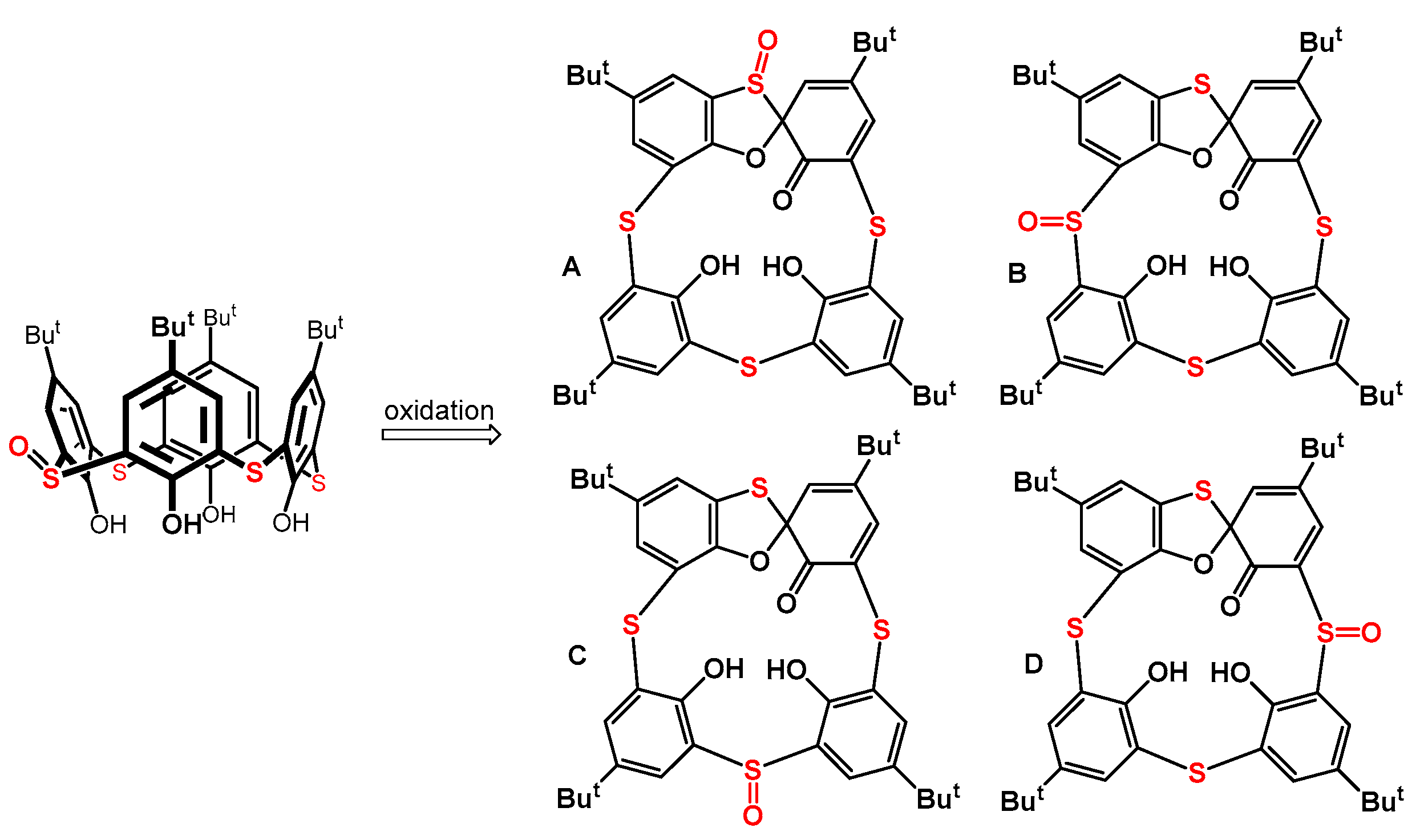
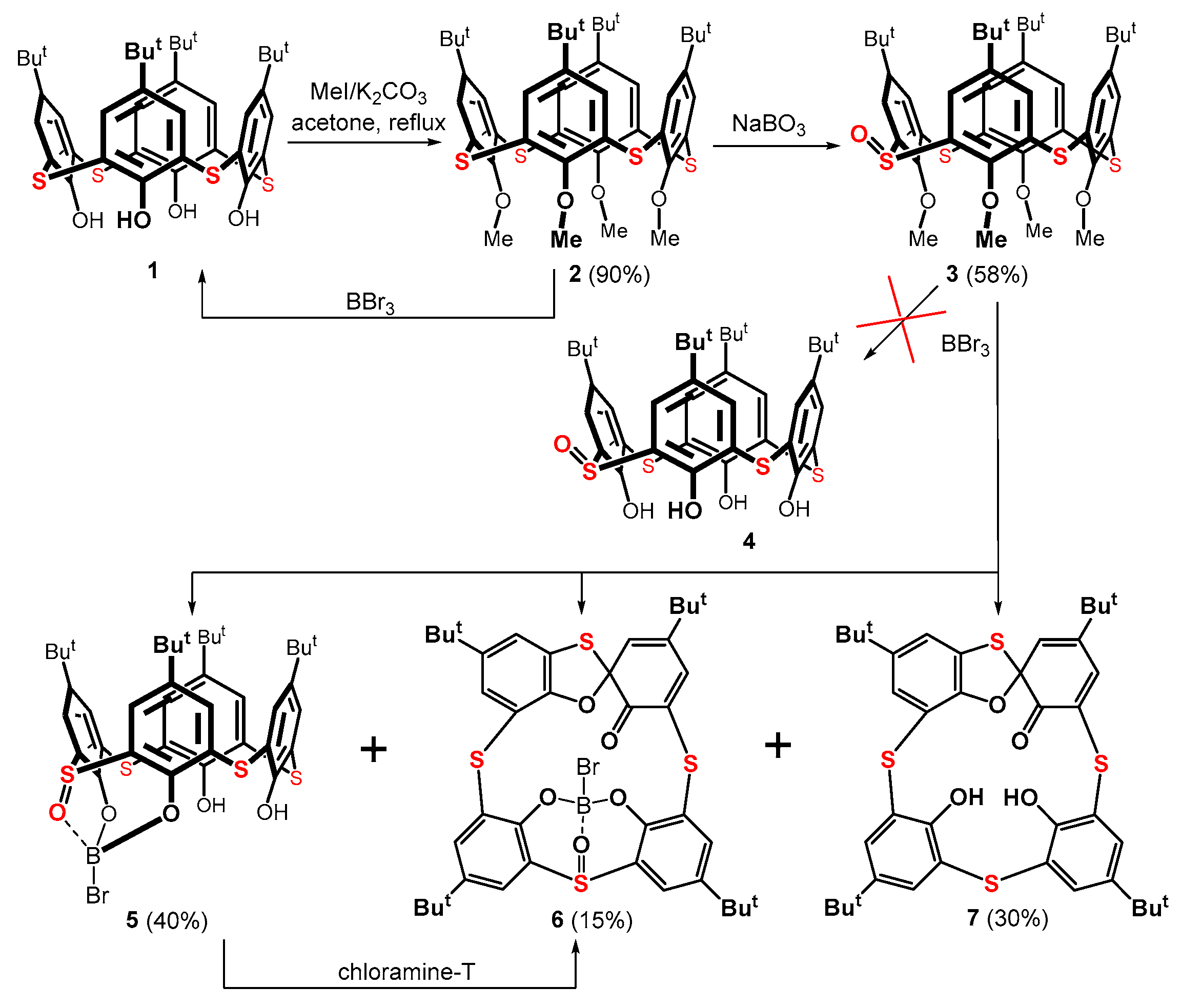
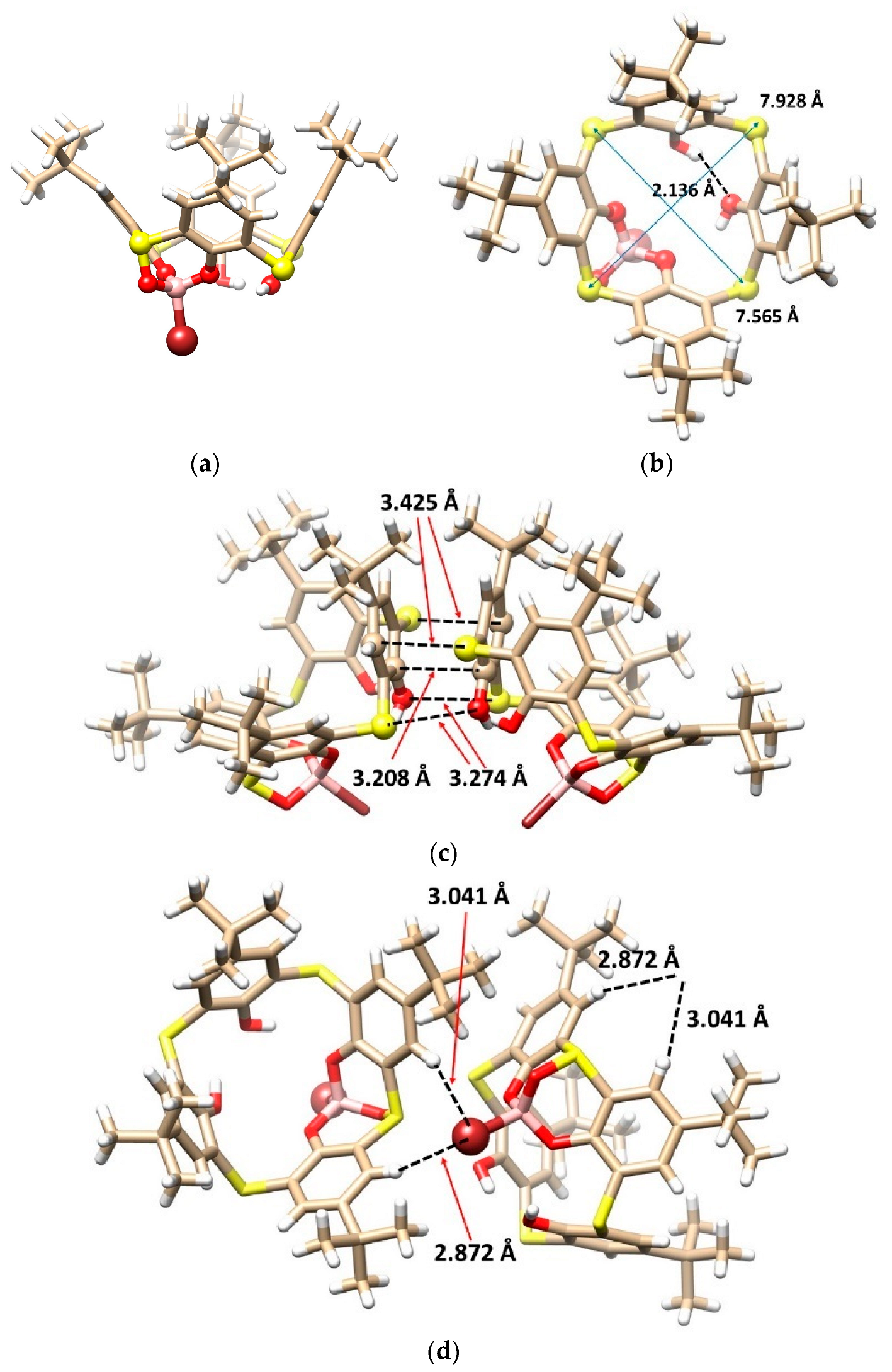




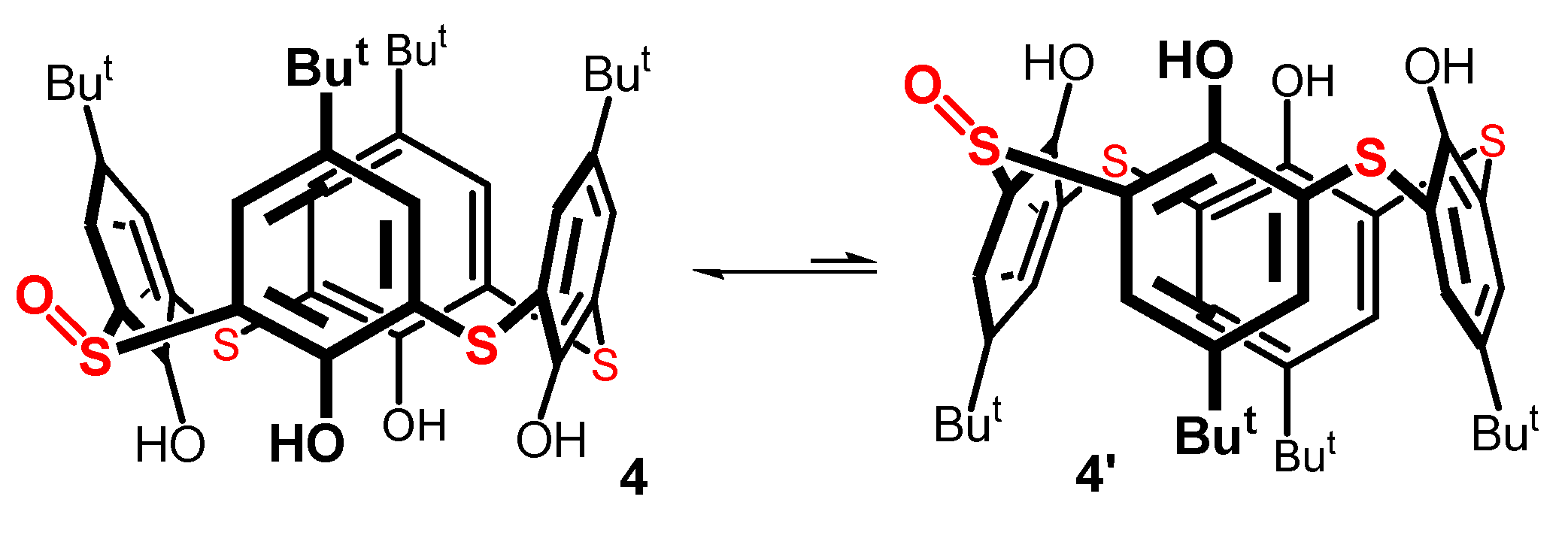
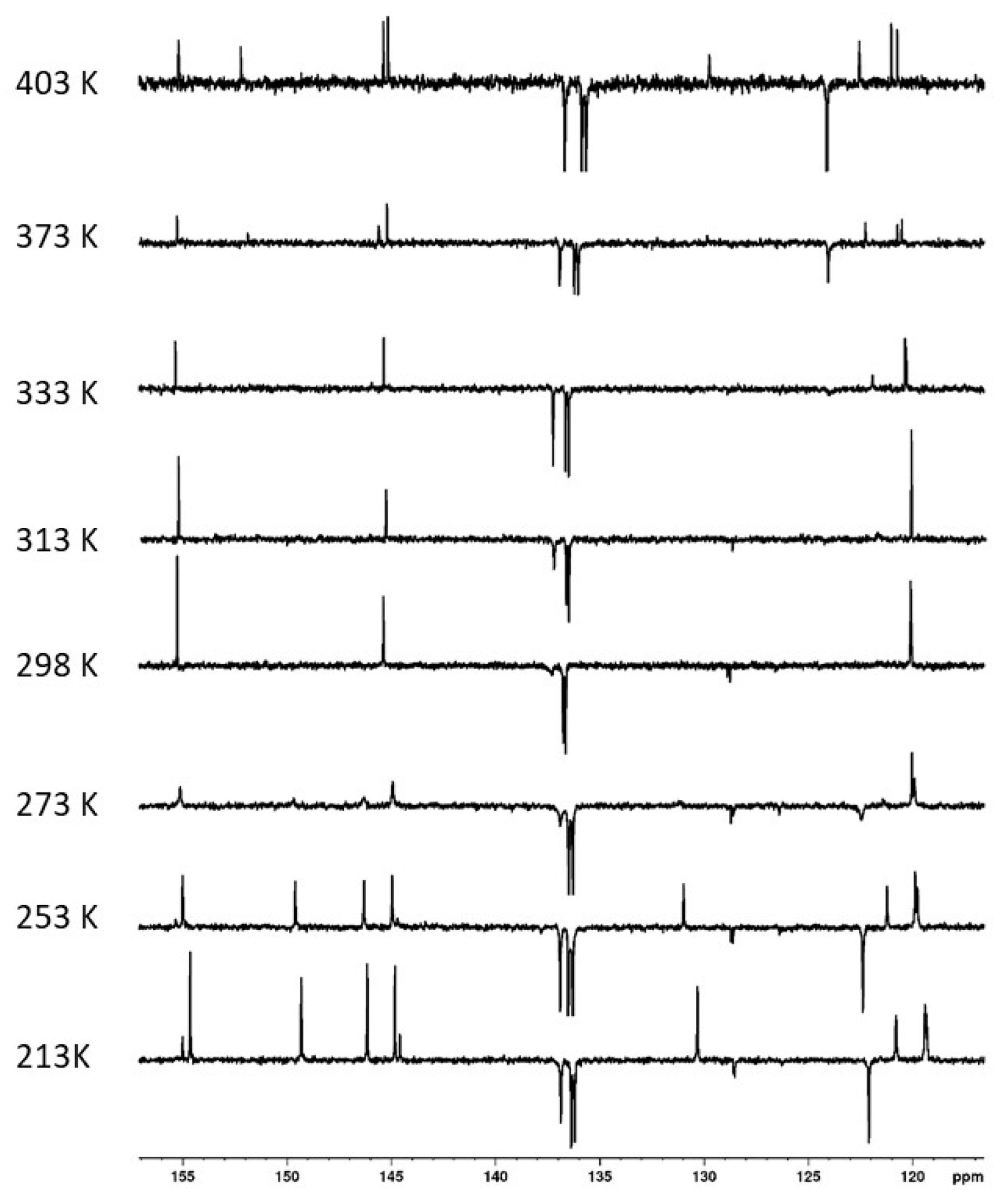
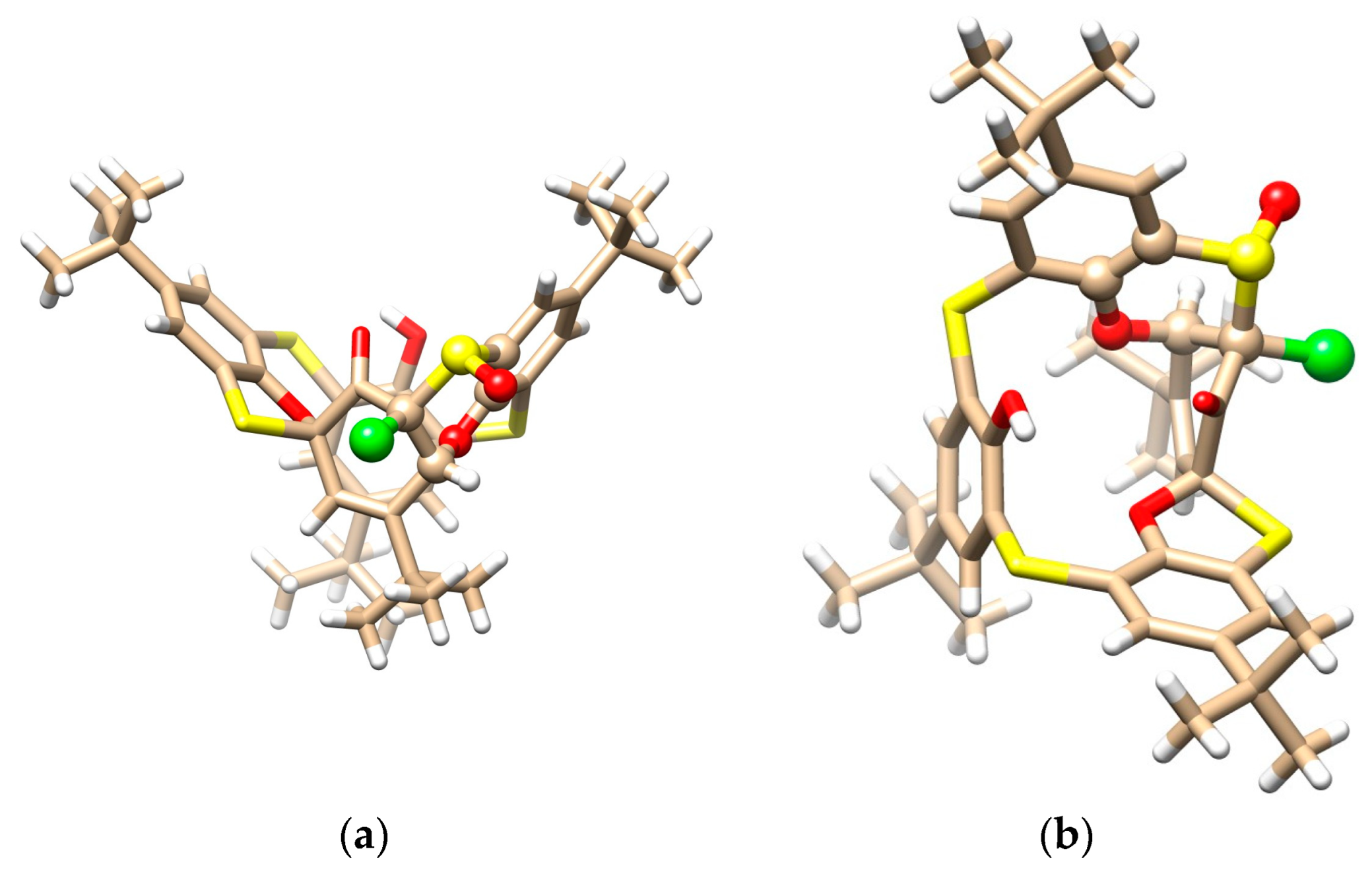
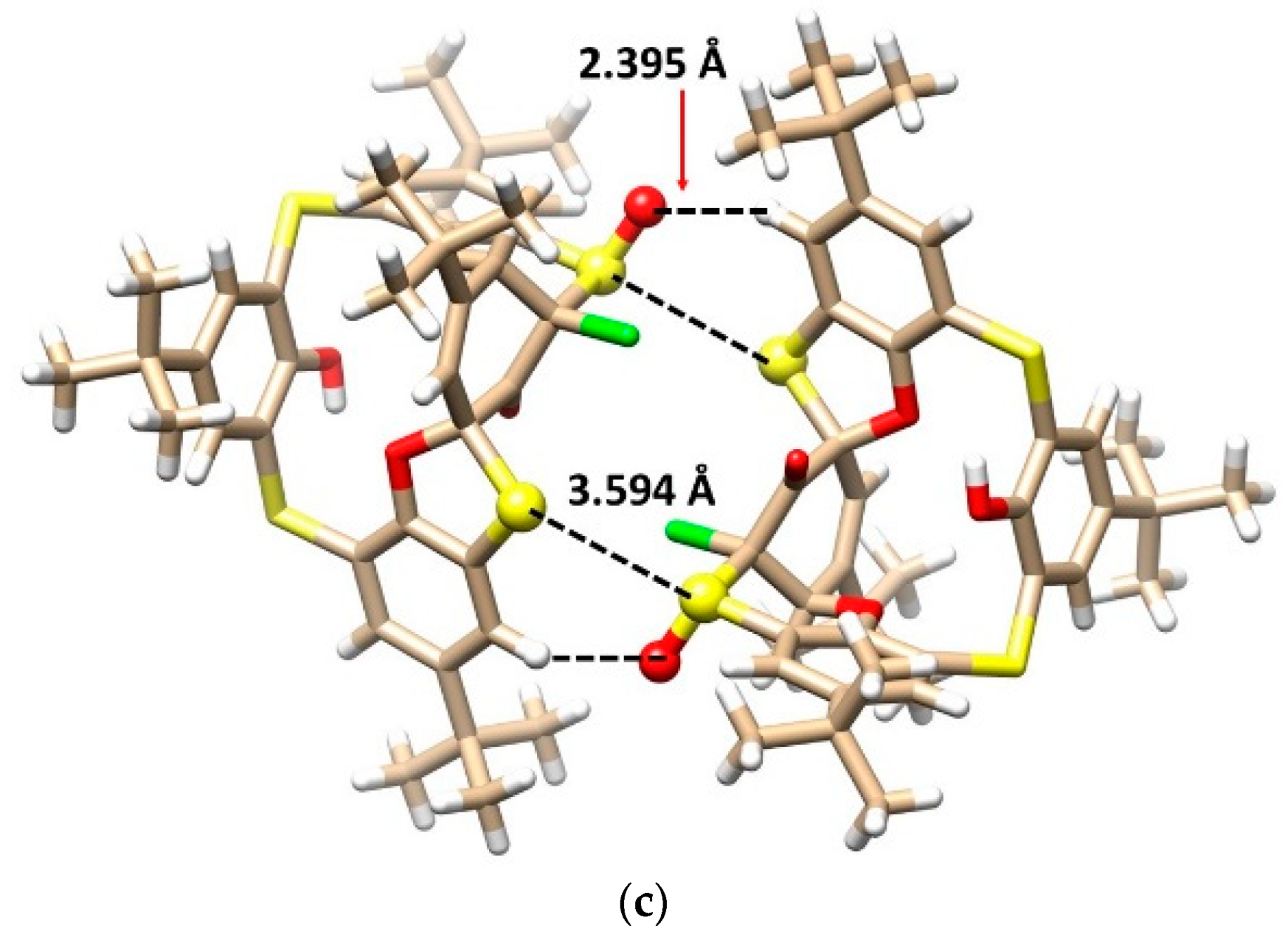

Disclaimer/Publisher’s Note: The statements, opinions and data contained in all publications are solely those of the individual author(s) and contributor(s) and not of MDPI and/or the editor(s). MDPI and/or the editor(s) disclaim responsibility for any injury to people or property resulting from any ideas, methods, instructions or products referred to in the content. |
© 2023 by the authors. Licensee MDPI, Basel, Switzerland. This article is an open access article distributed under the terms and conditions of the Creative Commons Attribution (CC BY) license (https://creativecommons.org/licenses/by/4.0/).
Share and Cite
Mamleev, K.; Eigner, V.; Dvořáková, H.; Lhoták, P. The Unexpected Chemistry of Thiacalix[4]arene Monosulfoxide. Molecules 2023, 28, 3914. https://doi.org/10.3390/molecules28093914
Mamleev K, Eigner V, Dvořáková H, Lhoták P. The Unexpected Chemistry of Thiacalix[4]arene Monosulfoxide. Molecules. 2023; 28(9):3914. https://doi.org/10.3390/molecules28093914
Chicago/Turabian StyleMamleev, Kamil, Václav Eigner, Hana Dvořáková, and Pavel Lhoták. 2023. "The Unexpected Chemistry of Thiacalix[4]arene Monosulfoxide" Molecules 28, no. 9: 3914. https://doi.org/10.3390/molecules28093914





